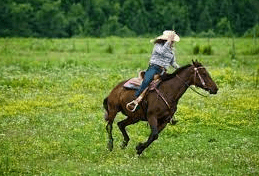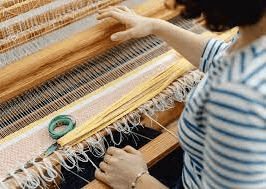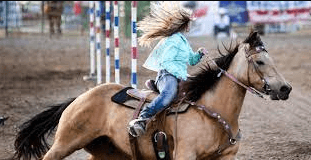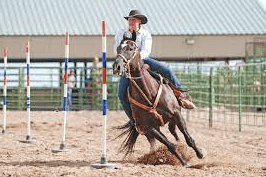Are There Any Specific Training Exercises To Enhance A Horse’s Agility And Maneuverability For Pole Bending?

Pole bending is a popular equestrian event that tests a horse’s agility and maneuverability as it weaves through a series of poles in a timed competition. To excel in pole bending, horses must possess strength, flexibility, speed, and balance. This article explores the specific training exercises that can enhance a horse’s abilities in pole bending, focusing on core muscle strength, quick transitions, flexibility and suppleness, speed and endurance, communication with the rider, obstacles and patterns introduction, balance and body control improvement, cross-training incorporation, and gradual increase in difficulty.
Developing core muscle strength is essential for enhancing a horse’s agility and maneuverability in pole bending. Targeted exercises such as trotting over ground poles or engaging in lateral work like leg yielding can help strengthen the deep abdominal muscles that provide stability to the horse’s spine during rapid direction changes. Additionally, incorporating hill work or cavalletti training can further engage the core muscles while improving overall body awareness.
Quick transitions play a crucial role in navigating through poles swiftly. Exercises such as frequent halts followed by prompt departures encourage horses to respond promptly to their rider’s cues. Practicing precise upward and downward transitions between gaits not only enhances the horse’s responsiveness but also aids in developing their coordination and balance. Moreover, incorporating lateral movements like shoulder-in or haunches-in encourages greater hind-end engagement while promoting better body control during tight turns around poles.
By implementing these training techniques with an emphasis on strength development, responsiveness to cues from the rider, coordination improvement through quick transitions along with other aspects mentioned above will surely elevate your horse’s performance when it comes to pole bending competitions.
Strengthen Core Muscles
One effective approach to improve a horse’s agility and maneuverability for pole bending is by implementing training exercises that focus on strengthening the core muscles.
Developing a strong core is essential for improving agility, balance, and coordination in horses.
Core muscles play a crucial role in stabilizing the horse’s body during quick turns and maneuvers, allowing them to maintain control and balance.
By targeting these muscles through specific exercises such as lateral flexion, shoulder-in movements, and engaging in activities like lunging or long-lining, horses can enhance their ability to navigate the poles with increased speed and quickness.
Strengthening the core also helps improve overall athleticism, enabling horses to perform more efficiently in pole bending competitions.
Incorporating these exercises into a regular training routine will not only benefit the horse’s performance but also contribute to their overall well-being by promoting strength and flexibility throughout their body.
Practice Quick Transitions
To enhance a horse’s agility and maneuverability for pole bending, it is important to incorporate frequent transitions between gaits during training sessions.
By regularly transitioning between walk, trot, and canter, horses develop the ability to adjust their speed and balance quickly, allowing them to navigate through tight turns with ease.
Additionally, focusing on smooth and precise changes of direction helps horses develop the coordination and responsiveness needed for successful pole bending runs.
Practicing these quick transitions not only improves a horse’s overall athleticism but also enhances their ability to navigate the poles efficiently.
Incorporate frequent transitions between gaits
By incorporating frequent transitions between gaits, the horse’s agility and maneuverability for pole bending can be likened to a graceful dancer effortlessly transitioning from one movement to another, captivating the audience with its fluidity and precision.
These transitions not only enhance the horse’s ability to navigate through the poles with ease but also improve its overall coordination and responsiveness to the rider’s cues.
To incorporate transitions effectively, it is important to practice changes of direction as well. This helps the horse develop flexibility in its body, enabling it to smoothly change directions while maintaining balance and control.
Furthermore, practicing frequent transitions between gaits allows the horse to develop strength in different muscles groups and improves its ability to adjust speed quickly, which is crucial when maneuvering through tight turns during pole bending.
Lastly, incorporating these training exercises fosters a deep connection between horse and rider as they work together harmoniously, creating a sense of freedom and unity that is truly exhilarating.
Focus on smooth and precise changes of direction
Focusing on smooth and precise changes of direction is essential for achieving fluidity and precision in pole bending. It enables the horse to gracefully navigate through the course with agility and control. To enhance a horse’s ability to make these changes effortlessly, various strengthening exercises and coordination drills can be incorporated into their training regimen.
Strengthening exercises such as lateral work, including leg yields and shoulder-ins, can help improve the horse’s flexibility and balance while performing tight turns. These exercises engage the horse’s hindquarters and core muscles, enhancing their ability to execute quick direction changes with ease.
Additionally, coordination drills such as serpentines or figure-eight patterns can further develop the horse’s maneuverability by requiring them to negotiate bends and transitions smoothly. By consistently practicing these exercises, horses can develop the necessary strength, coordination, and responsiveness needed for successful pole bending performances.
Work on Flexibility and Suppleness
To enhance a horse’s flexibility and suppleness, it is beneficial to incorporate stretches and bending exercises into their training routine.
These exercises help to improve the horse’s range of motion and increase their ability to bend and flex in different directions.
Additionally, using lateral movements such as leg yields and shoulder-in can further develop the horse’s flexibility and suppleness by encouraging them to engage their hind end and move laterally with ease.
Include stretches and bending exercises in the horse’s training routine
Incorporating stretches and bending exercises into a horse’s training routine cultivates an environment that encourages enhanced agility and maneuverability for pole bending, ultimately contributing to their overall performance in the sport.
By including these exercises, horses can develop the necessary flexibility and suppleness needed to navigate through poles with ease.
Here are four specific activities that can be incorporated into a horse’s training routine to improve their agility and maneuverability:
- Shoulder-in: This exercise involves asking the horse to move their shoulders inward while maintaining forward movement. It helps improve the horse’s lateral flexibility, making them more responsive to rider cues during pole bending.
- Leg yields: Leg yielding requires the horse to move sideways while maintaining forward momentum. This exercise improves the horse’s ability to bend laterally and shift weight onto their hindquarters, which is crucial for quick turns around poles.
- Serpentines: Incorporating serpentine patterns into a horse’s training routine can help improve their balance, coordination, and responsiveness to rider aids. The constant changes of direction and bending movements involved in serpentines mimic the demands of pole bending courses.
- Cavaletti work: Setting up cavaletti poles at varying heights and distances challenges the horse’s coordination, balance, and adjustability while going over obstacles. This exercise strengthens their core muscles and improves their ability to make quick footwork adjustments during pole bending runs.
By incorporating these strengthening exercises and agility drills into a horse’s training routine, riders can enhance their equine partner’s overall athleticism for pole bending competitions while promoting physical well-being and freedom of movement.
Use lateral movements to improve flexibility and suppleness
Utilizing lateral movements in a horse’s training routine can enhance their flexibility and suppleness, allowing for graceful and fluid movements akin to a dancer gracefully gliding across the stage.
Lateral movement progression is an effective method to improve a horse’s agility and maneuverability for pole bending.
By incorporating suppling exercises such as leg-yielding, shoulder-in, haunches-in, and half-pass into their training program, horses can develop greater flexibility in their joints and muscles.
These exercises encourage the horse to engage their hindquarters, shift their weight onto the inside hind leg, and move laterally with precision.
As the horse becomes more proficient in these lateral movements, they will gain increased control over each foot placement, resulting in improved balance and coordination during pole bending.
The supple nature of these exercises also aids in preventing stiffness or resistance that may hinder the horse’s ability to navigate tight turns around poles with ease.
In essence, incorporating lateral movements into a horse’s training routine not only enhances their flexibility and suppleness but also contributes to their overall agility and maneuverability for pole bending.
Develop Speed and Endurance
Enhancing a horse’s agility and maneuverability for pole bending involves implementing training exercises that focus on developing speed and endurance, similar to sculpting a finely-tuned athlete.
To develop balance and coordination, various exercises can be incorporated into the horse’s training regimen. These may include working on serpentines and figure eights, which require the horse to change direction quickly while maintaining their balance.
Additionally, incorporating cavaletti work can help improve agility and quickness by encouraging the horse to lift their legs higher and shorten their stride in order to navigate over the poles. This not only improves their overall athleticism but also enhances their ability to make quick turns around the poles during a pole bending course.
Furthermore, interval training can be an effective method to develop speed and endurance in horses. By alternating periods of high-intensity work with periods of rest or lower intensity work, horses can build up their cardiovascular fitness and stamina, allowing them to perform at optimal levels during pole bending competitions.
Overall, by focusing on these aspects of training, horses can become more agile and maneuverable for pole bending events, ultimately leading to improved performance on the course.
Fine-Tune Communication with the Rider
To optimize performance in pole bending competitions, it is crucial to establish effective communication between the horse and rider. This can be achieved by improving responsiveness and refining cues. Here are some training exercises that can help enhance communication between the horse and rider:
- Groundwork: Practicing groundwork exercises such as lunging, long-lining, and liberty work can improve the horse’s responsiveness to cues from the rider. These exercises focus on developing communication through body language and clear signals.
- Transitions: Incorporating frequent transitions between gaits during riding sessions helps refine the horse’s understanding of subtle cues from the rider. This exercise improves the horse’s ability to respond quickly and smoothly to changes in speed or direction.
- Obstacle courses: Setting up obstacle courses that require precise maneuvers can enhance a horse’s agility and responsiveness. Exercises such as weaving through cones, navigating tight turns, or backing up through poles help fine-tune the horse’s ability to maneuver with precision.
- Pattern practice: Regularly practicing pole bending patterns helps horses become more familiar with the specific movements required for this discipline. By repeating these patterns at varying speeds, riders can refine their cues while helping horses anticipate upcoming maneuvers.
By incorporating these training exercises into a regular routine, riders can improve communication with their horses, leading to enhanced agility and maneuverability in pole bending competitions.
Introduce Obstacles and Patterns
Introducing various obstacles and practicing specific patterns can significantly contribute to improving the horse’s performance in pole bending competitions. These exercises help strengthen the horse’s hindquarters, which are crucial for agility and maneuverability.
By incorporating obstacles such as cones or barrels into training sessions, the horse learns to navigate tight turns and quick changes of direction. This improves their coordination and ability to respond quickly to rider cues.
Additionally, practicing specific patterns such as figure eights or serpentines helps the horse become more supple and responsive to the rider’s aids. These exercises require precision and control, allowing the horse to develop a greater level of athleticism and finesse necessary for successful pole bending runs.
Overall, incorporating obstacles and patterns into training routines provides valuable opportunities for horses to enhance their agility, coordination, and overall performance in pole bending competitions.
Focus on Balance and Body Control
One crucial aspect of training for pole bending competitions is the focus on achieving balance and body control, but how can riders ensure that their horses develop these skills effectively?
To enhance a horse’s agility and maneuverability for pole bending, riders can incorporate various balance exercises and body control drills into their training regimen. These exercises help horses improve their proprioception, coordination, and flexibility, leading to better overall performance in pole bending.
Some examples of balance exercises include:
- practicing riding over ground poles or cavaletti at different speeds and gaits
- performing lateral movements such as leg yields or shoulder-in
Additionally, body control drills such as serpentines or figure-eight patterns can help horses develop greater responsiveness to rider cues and improve their ability to navigate tight turns around the poles.
By consistently incorporating these types of exercises into training sessions, riders can help their horses become more balanced, agile, and precise in pole bending competitions.
Incorporate Cross-Training
Incorporating cross-training into a horse’s routine can greatly benefit their overall fitness and performance.
Engaging in activities such as trail riding or jumping not only helps to improve the horse’s cardiovascular endurance and muscle strength, but also provides mental stimulation and a change of scenery.
Varying the horse’s training routine is important to prevent boredom and promote versatility, as it challenges them both physically and mentally, ultimately enhancing their agility and maneuverability for pole bending.
Engage in activities such as trail riding or jumping to improve overall fitness
Engaging in activities such as trail riding or jumping can contribute to the enhancement of a horse’s overall fitness, which is crucial for improving its agility and maneuverability in pole bending.
Incorporating dressage exercises into the training regimen helps to develop the horse’s balance, suppleness, and responsiveness to aids. These exercises focus on precise movements and transitions that require the horse to engage its hindquarters and maintain a collected frame.
Additionally, utilizing ground poles for conditioning can help improve the horse’s coordination, strength, and flexibility. By incorporating pole work into their training routine, horses learn to navigate through obstacles with precision and speed. This type of exercise also helps them develop better body awareness and spatial perception, which are essential skills for successfully maneuvering through the poles during a pole bending competition.
Overall, engaging in activities like trail riding or jumping along with incorporating dressage exercises and utilizing ground poles can greatly enhance a horse’s overall fitness level, leading to improved agility and maneuverability in pole bending events.
Vary the horse’s training routine to prevent boredom and promote versatility
To prevent monotony and foster versatility, it is imperative to introduce a range of diverse activities into the horse’s training routine.
Incorporating strengthening exercises and mental stimulation into the horse’s training regimen can greatly enhance its agility and maneuverability for pole bending.
These exercises can include lateral work such as shoulder-in, haunches-in, and leg yields, which not only strengthen the horse’s muscles but also improve its balance and coordination.
Additionally, incorporating cavaletti work or grid exercises can help improve the horse’s jumping ability and overall athleticism.
By varying the training routine with different activities, the horse is constantly challenged both physically and mentally, preventing boredom and promoting adaptability in different situations.
This not only enhances their performance in pole bending but also improves their overall fitness and well-being as they become more versatile athletes.
Gradually Increase Difficulty
The gradual increase in difficulty during training exercises can effectively enhance a horse’s agility and maneuverability for pole bending, leading to a sense of accomplishment and fulfillment in both the rider and the horse.
To strengthen a horse’s abilities in pole bending, incorporating specific strengthening exercises and agility drills is crucial. These exercises should focus on developing core strength, flexibility, balance, coordination, and speed.
Gradually increasing the difficulty of these exercises over time challenges the horse’s physical capabilities and encourages them to push their limits. For example, starting with basic patterns such as weaving through poles at a slower pace and then gradually increasing the speed and complexity of the patterns will help improve the horse’s ability to navigate tight turns smoothly.
Additionally, introducing obstacles such as cones or barrels in between poles can further challenge their maneuverability skills.
By consistently pushing the boundaries of what they can achieve, horses develop increased dexterity and adaptability necessary for successful pole bending competitions.
Frequently Asked Questions
How long does it typically take to see improvements in a horse’s agility and maneuverability with these training exercises?
The training duration required to observe improvements in a horse’s agility and maneuverability can vary depending on various factors such as the horse’s current abilities, age, and level of prior training. Measuring progress typically involves assessing the horse’s performance in pole bending exercises over time.
Can these exercises be beneficial for horses of all ages and experience levels?
The exercises discussed can be beneficial for horses of all ages and experience levels. They offer numerous benefits, including improved agility and maneuverability, regardless of the horse’s age or level of experience.
Are there any specific warm-up exercises that should be done before starting these training exercises?
To ensure optimal performance and prevent injuries, specific warm-up exercises are crucial before engaging in pole bending training. Stretching is of utmost importance as it increases flexibility, improves range of motion, and prepares the horse’s muscles for the demands of the activity.
What are some common mistakes or challenges that riders may encounter while practicing these exercises?
Common mistakes riders may encounter while practicing pole bending exercises include improper positioning, lack of balance and coordination, incorrect timing and cues, and not properly preparing the horse for the activity. These challenges can hinder the horse’s agility and maneuverability.
Are there any safety precautions or considerations that should be taken into account when incorporating obstacles and patterns into training sessions?
When incorporating training obstacles into sessions, it is important to prioritize safety precautions. Riders should ensure that obstacles are properly set up and maintained, and that horses are trained gradually and consistently to navigate them.
Conclusion
In conclusion, enhancing a horse’s agility and maneuverability for pole bending requires a systematic approach that focuses on strengthening core muscles, practicing quick transitions, and working on flexibility and suppleness.
Developing speed and endurance, fine-tuning communication with the rider, introducing obstacles and patterns, and focusing on balance and body control are also crucial aspects of training.
One important aspect to remember is to incorporate cross-training into the horse’s routine. This can involve incorporating exercises from other disciplines such as dressage or jumping to help improve overall athleticism. By gradually increasing the difficulty level of the exercises over time, horses can further enhance their agility and maneuverability.
As the saying goes, ‘Practice makes perfect.’ Consistency in training sessions is key to achieving success in pole bending. It is through regular practice that horses become more responsive to their riders’ cues and develop the necessary muscle memory for quick turns around poles. With patience, dedication, and a well-rounded training program encompassing various aspects of fitness and skill development, horses can reach their full potential in pole bending competitions.
In summary, enhancing a horse’s agility and maneuverability for pole bending requires a comprehensive training program that targets core strength, flexibility, speed, endurance, balance, body control, and effective communication with the rider. Gradually increasing difficulty levels while incorporating cross-training exercises will further improve performance. Consistency in practice is essential.
An old adage reminds us, ‘Rome wasn’t built in a day.’ By investing time, money, and effort into proper training, horses can excel at pole bending competitions, evoking awe-inspiring performances from both judges and spectators alike.


